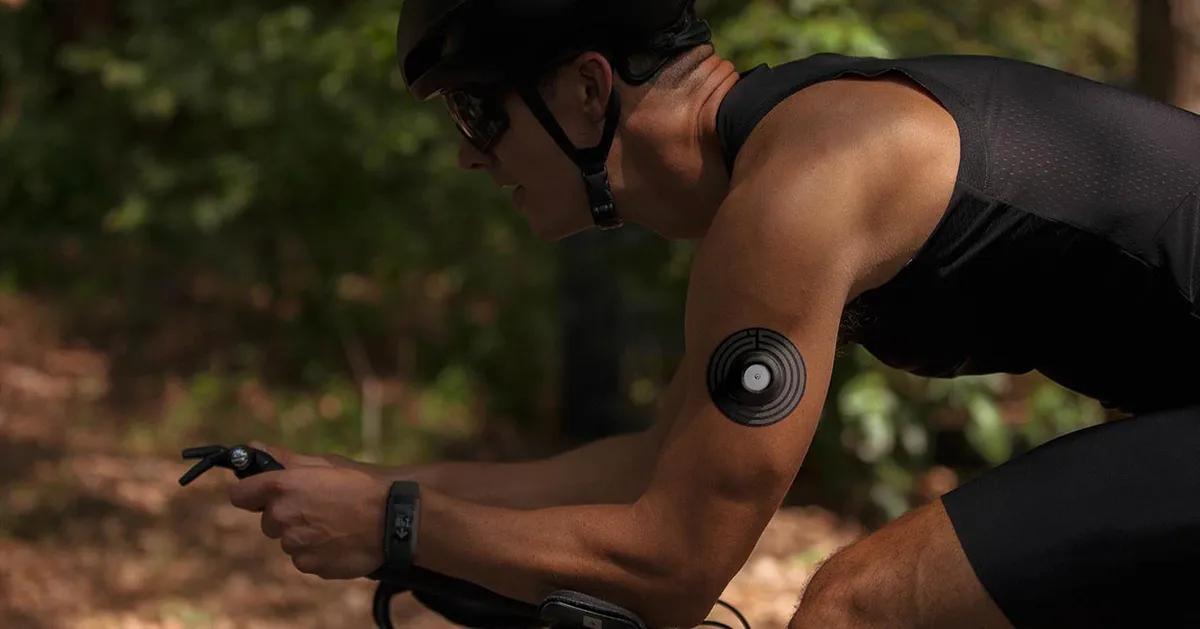Continuous glucose monitors have become much more widely known in recent years, with Supersapiens sponsoring a number of significant triathlon events and some pro triathletes turning to the devices to help them get an edge.
Below, one of 220's expert gear testers puts two options to the test, but first, what exactly is a continuous glucose monitor (CGM)?
Well, a CGM is a device that provides a continual measurement of the level of glucose in your blood, which is also sometimes referenced as your blood sugar levels.
The device is able to provide readings throughout night and day, giving you a real-time insight into how your body is reacting to the food and drinks you're consuming.
This type of device is useful for people at risk of diabetes for obvious reasons, but it's also possible that athletes will see benefits from using a CGM, as it may allow you to analyse or plan fuelling strategies for training and racing.
Some devices, such as Supersapiens provide a constant stream of data for you to look over, while others, such as Levels, require you to tap your phone to it in order to load up the latest batch of info.
Now that's clear, let's hand over to former 220 Triathlon editor James Witts and see what he made of two leading CGMs.
Supersapiens reviewed
- From £130 for two sensors (28 days’ worth)
Supersapiens is the world’s first ‘athlete-driven’ continuous glucose monitoring device that sees Chris Froome as one of its investors, is used by Jan Frodeno and, up until this year, was the title sponsor of the Ironman World Championship.
Supersapiens uses an Abbot Libre sensor that comprises a wafer-thin 5mm-long needle that you clamp into your arm.
It’s painless and then sticks to your skin with a strong adhesive that remains stable in a shower and swimming, though added support comes from a performance patch.
The sensor lasts 14 days and in that time you’re given a wealth of data to pore over in search of improved feeding, both generally and in training.
And it’s that last part that elevates Supersapiens above Levels in the triathlon sphere, as the sensor streams your glucose data to your phone in real time for on-the-fly feedback.

What does this mean? One scenario might see your glucose levels dropping 90km into an Ironman bike, so you can base on empirical evidence that it’s time to knock back an energy gel.
Impressively and usefully, it syncs with a number of third-party apps and hardware including the Wahoo Elemnt, in this case meaning you can leave your phone at home.
The app’s not quite as clear as the Levels’ option but arguably that comes down to a deeper dig into the data; in short, to optimise its use, you must spend time educating yourself into what each data field means. The Supersapiens app and website is useful here.
On the downside – and this applies to both – it’s not cheap and there’s a scepticism in some quarters of actually how useful the data is from a CGM (continuous glucose monitor) in an athletic population.
As research in this area grows, this scepticism will presumably dilute or strengthen.
Verdict: Potentially beneficial for the committed albeit takes some education.
Score: 78%
Levels reviewed
- £205 annual membership to the app; £129 for every two sensors (28 days' worth)
First things first, at time of press Levels wasn’t commercially available in the UK, but it is expected to make the jump across the pond later this year.
We were testing the Beta version, but it’s been available in the US for a while. It uses the same Abbot Libre sensor as Supersapiens so, again, it’s surprisingly imperceptible and lasts for 14 days.
It also comes with an extra plaster for added security, though doesn’t look as swanky as its competitor’s.
For the Beta version, you downloaded the Abbot Libre app and sync it to Levels. Once Beta’s complete, of course, you’ll receive the same information direct to Levels. And the delivery of that information is a big sell of Levels as it’s clear and usable.
Like Supersapiens, data’s tracked over the short- and long-term to spot any glucose-related trends. Key to this on the Levels platform is the ‘Stability Score’ where you aim for a score of around 70-90 in search of a healthy metabolism.

The aim is to avoid too high a spike – and subsequent crash. Sadly, the biggest spike derived from a pint of craft ale. Not unexpectedly, porridge and brown rice delivered a healthy, slow delivery that kept glucose stable.
Rather neatly, you can add what food you’ve eaten. Levels then wades through its library of foods and recipes to judge how good a food choice this was, taking this teaching one step further with its vast pool of content.
For instance, a spoonful of my wife’s treacle tart sent me spiking, which Levels then linked to a piece on the dangers of processed fructose.
As a health tool, it’s impressive. But as a performance tool, it lacks the depth of Supersapiens, lacking on-the-fly glucose feedback, for example.
Unlike Supersapiens, you also have to scan the sensor each time you’re after data.
Verdict: Usable but more health-orientated and very expensive
Score: 73%
